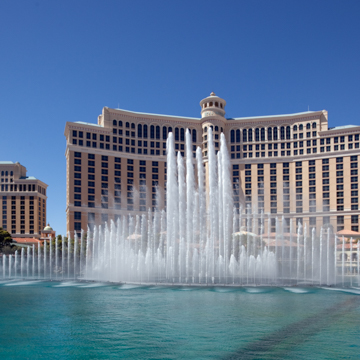The latest of Mirage Resorts' mega-resorts, Bellagio—very loosely based on the Italian village at Lake Como—makes an effort to bring a European ambience to the Strip. Built at a cost of $1.6 billion, the resort covers 122 acres, formerly the site of the Dunes Hotel, which was imploded in 1993. Like the Mirage, Bellagio is surrounded by a contrived landscape, including tropical gardens and an eleven-acre man-made lake. The public attraction here is a water ballet of fountains, accompanied by lights and music. Beyond the lake is the hotel's thirty-six-story main building, with three wings spreading from a central curved shaft topped by a cupola. At the base of the tower is a cluster of buildings with red tile roofs emulating Italian villas and containing elegant, expensive shops and restaurants.
Bellagio's artificial nostalgia for a prosperous past and glamorous foreign resorts is characteristic of appeals to the newly rich since the 1990s. It is one of a number of new hotel-casinos reaching out to affluent customers by offering luxurious rooms, branches of expensive and well-known restaurants, and shopping malls featuring exclusive stores. Bellagio's first owner, Steve Wynn, opened a gallery here to display his French Impressionist and old master paintings—a first for a Strip resort. Also designed to attract visitors is the private monorail carrying guests from Bellagio to Monte Carlo, another Mirage Resorts casino on the Strip. The monorail not only enables patrons to avoid driving or walking on crowded roads or sidewalks but also encourages them to remain in casinos owned by the same company. In 2000 MGM Grand, Inc., purchased Mirage Resorts, including Bellagio. It is likely that MGM will sell off most of the art collection.

















